Decoding Agricultural Drought Resilience: A Triple-Validated Random Forest Framework Integrating Multi-Source Remote Sensing for High-Resolution Monitoring in the North China Plain
Abstract
:1. Introduction
2. Materials and Methods
2.1. Study Areas
2.2. Time Series Data Acquisitions
2.2.1. MODIS Products
2.2.2. Soil Moisture Data
2.2.3. Meteorological Data
2.2.4. Terrain and Soil Data
2.3. Methods
2.3.1. Integrated Framework Design
2.3.2. Drought Index Calculations
- (1)
- Vegetation Condition Index (VCI)
- (2)
- Temperature Condition Index (TCI)
- (3)
- Precipitation Condition Index (PCI)
- (4)
- Additional Input Factors
2.3.3. Model Development
- (1)
- Random Forest Model Framework
- (2)
- Model Training Process
- (3)
- Model Evaluation Metrics
- (4)
- Model Validation Scheme
- (5)
- Model Parameter Optimization and Innovative Features
3. Experiments and Results
3.1. Model Validation Results
3.1.1. Model Accuracy Assessment Based on SPEI
3.1.2. Validation Based on Comprehensive Meteorological Drought Index
3.1.3. Soil Moisture Response Validation
3.1.4. Model Sensitivity Analysis
3.1.5. Validation of Drought Processes in Typical Years
3.1.6. Model Uncertainty Analysis
3.2. Analysis of Spatiotemporal Characteristics of Drought
3.2.1. Drought Frequency Analysis
3.2.2. Drought Intensity Assessment
3.2.3. Seasonal Variation Characteristics
3.2.4. Analysis of Spatial Heterogeneity
3.2.5. Long-Term Trends
4. Discussion
5. Conclusions
- (1)
- Multi-level validation of model prediction results demonstrates that the CIDI model exhibits strong capability in monthly drought identification. In the test dataset, the model generally achieved correlation coefficients (R2) above 0.8 with SPEI, reached correlations of 0.73 and 0.86 with the comprehensive meteorological drought index (CI) in summer and autumn, respectively, and showed significant correlation (R > 0.5) with soil relative humidity data. These results verify the model’s reliability across different spatiotemporal scales.
- (2)
- Analysis of drought evolution characteristics in the North China Plain from 2000 to 2019 reveals that moderate drought occurred most frequently, with months exceeding 20% of the total drought ratio reaching 186; drought showed significant seasonal variations, with summer being the peak period, particularly in central and southern Shandong and eastern Henan regions where drought frequency reached 12–15 months, coinciding with critical crop growth periods; the study area exhibited an overall drying trend, with notably intensified drought conditions during 2010–2012 and 2014–2016.
- (3)
- The CIDI model overcomes the limitations of traditional single-index methods by integrating multiple remote sensing indices (VCI, TCI, PCI), providing a new technical approach for regional drought monitoring. The model’s high spatial resolution (1 km) and good timeliness enable it to provide timely, detailed spatial information support for agricultural production planning and drought mitigation decision-making.
Supplementary Materials
Author Contributions
Funding
Data Availability Statement
Acknowledgments
Conflicts of Interest
References
- Laughlin, A.; Galgano, F.A. Spatial and temporal patterns of drought and violence in Darfur, Sudan. Afr. Secur. Rev. 2025, 34, 60–83. [Google Scholar] [CrossRef]
- Mishra, A.K.; Singh, V.P. A review of drought concepts. J. Hydrol. 2010, 391, 202–216. [Google Scholar] [CrossRef]
- Tuğrul, T.; Hınıs, M.A.; Oruç, S. Comparison of LSTM and SVM methods through wavelet decomposition in drought forecasting. Earth Sci. Inform. 2025, 18, 139. [Google Scholar] [CrossRef]
- Wilhite, D.A.; Svoboda, M.D.; Hayes, M.J. Understanding the complex impacts of drought: A key to enhancing drought mitigation and preparedness. J. Hydrol. 2007, 21, 763–774. [Google Scholar] [CrossRef]
- Bekana, T.H. Drought Risk Management in Ethiopia: A Systematic Review. J. Energy Environ. Chem. Eng. 2025, 10, 1–11. [Google Scholar] [CrossRef]
- Van Loon, A.F. Hydrological drought explained. Wiley Interdiscip. Rev. Water 2015, 2, 359–392. [Google Scholar] [CrossRef]
- Dai, A. Drought under global warming: A review. Wiley Interdiscip. Rev. Clim. Change 2011, 2, 45–65. [Google Scholar] [CrossRef]
- Williams, A.P.; Cook, B.I.; Smerdon, J.E. Rapid intensification of the emerging southwestern North American megadrought in 2020–2021. Nat. Clim. Change 2022, 12, 232–234. [Google Scholar] [CrossRef]
- Pendergrass, A.G.; Meehl, G.A.; Pulwarty, R.; Hobbins, M.; Hoell, A.; AghaKouchak, A.; Bonfils, C.J.W.; Gallant, A.J.E.; Hoerling, M.; Hoffmann, D.; et al. Flash droughts present a new challenge for subseasonal-to-seasonal prediction. Nat. Clim. Change 2020, 10, 191–199. [Google Scholar] [CrossRef]
- Carrão, H.; Naumann, G.; Barbosa, P. Global projections of drought hazard in a warming climate: A prime for disaster risk management. Clim. Dyn. 2018, 50, 2137–2155. [Google Scholar] [CrossRef]
- Cook, B.I.; Mankin, J.S.; Anchukaitis, K.J. Climate Change and Drought: From Past to Future. Curr. Clim. Change Rep. 2018, 4, 164–179. [Google Scholar] [CrossRef]
- Ma, Z.X.; Cui, H.J.; Ge, Q.S. Future climatic risks faced by the Beautiful China Initiative: A perspective for 2035 and 2050. Adv. Clim. Change Res. 2025, 16, 141–153. [Google Scholar] [CrossRef]
- Sun, M.; Dai, Y.; Zhang, S.; Liang, H. Risk Assessment of Extreme Drought and Extreme Wetness During Growth Stages of Major Crops in China. Sustainability 2025, 17, 2221. [Google Scholar] [CrossRef]
- Wang, L.; Chen, W. A CMIP5 multimodel projection of future temperature, precipitation, and climatological drought in China. Int. J. Climatol. 2014, 34, 2059–2078. [Google Scholar] [CrossRef]
- Zhang, Q.; Yao, Y.; Li, Y.; Huang, J.; Ma, Z.; Wang, Z.; Wang, S.; Wang, Y.; Zhang, Y. Progress and prospect on the study of causes and variation regularity of droughts in China. Acta Meteorol. Sin. 2020, 78, 500–521. [Google Scholar] [CrossRef]
- Liu, J.; Li, M.; Li, R.; Shalamzari, M.J.; Ren, Y.; Silakhori, E. Comprehensive Assessment of Drought Susceptibility Using Predictive Modeling, Climate Change Projections, and Land Use Dynamics for Sustainable Management. Land 2025, 14, 337. [Google Scholar] [CrossRef]
- Zhuang, Y.; Fuller, D.Q. Landscape of Loess, Millets, and Boar: The Environmental Contexts of Early Cultivars in Northern China. Curr. Anthropol. 2024, 65, S3–S31. [Google Scholar] [CrossRef]
- Lu, E.; Luo, Y.; Zhang, R.; Wu, Q.; Liu, L. Changes in the drought over China during 1951–2010. Adv. Atmos. Sci. 2012, 29, 1636–1648. [Google Scholar]
- Wang, P.; Zhang, Q.; Yang, Y.; Yu, Z.; Ren, L.; Yao, C. Drought characteristics and propagation in the semiarid region of China based on multiple drought indices and SPEI. Sci. Total Environ. 2021, 741, 140438. [Google Scholar]
- Feng, W.; Zhong, M.; Lemoine, J.M.; Biancale, R.; Hsu, H.T.; Xia, J. Evaluation of groundwater depletion in North China using the Gravity Recovery and Climate Experiment (GRACE) data and ground-based measurements. Water Resour. Res. 2018, 49, 2110–2118. [Google Scholar] [CrossRef]
- Hu, X.; Shi, L.; Zeng, J.; Yang, J.; Zha, Y.; Yao, Y.; Cao, G. Estimation of actual irrigation amount and its impact on groundwater depletion: A case study in the Hebei Plain, China. J. Hydrol. 2016, 543, 433–449. [Google Scholar] [CrossRef]
- Fang, Q.; Ma, L.; Green, T.R.; Yu, Q.; Wang, T.D.; Ahuja, L.R. Water resources and water use efficiency in the North China Plain: Current status and agronomic management options. J. Hydrol. 2010, 97, 1102–1116. [Google Scholar] [CrossRef]
- Yin, L.; Tao, F.; Chen, Y.; Wang, Y. Reducing agriculture irrigation water consumption through reshaping cropping systems across China. Agric. For. Meteorol. 2022, 312, 108707. [Google Scholar] [CrossRef]
- Palmer, W.C. Meteorological Drought; Research Paper No. 45; U.S. Department of Commerce Weather Bureau: Washington, DC, USA, 1965. [Google Scholar]
- Kogan, F.; Guo, W.; Yang, W. Drought and food security prediction from NOAA new generation of operational satellites. Geomat. Nat. Hazards Risk 2019, 10, 651–666. [Google Scholar] [CrossRef]
- AghaKouchak, A.; Farahmand, A.; Melton, F.S.; Teixeira, J.; Anderson, M.C.; Wardlow, B.D.; Hain, C.R. Remote sensing of drought: Progress, challenges and opportunities. Rev. Geophys. 2015, 53, 452–480. [Google Scholar] [CrossRef]
- Wang, H.; Chen, Y.; Pan, Y.; Li, W. Drought forecasting based on support vector machine with improved dragonfly algorithm. J. Hydrol. 2022, 605, 127318. [Google Scholar]
- Zhang, X.; Chen, N.; Li, J.; Chen, Z.; Niyogi, D. Multi-sensor integrated framework and index for agricultural drought monitoring. Remote Sens. Environ. 2021, 260, 112436. [Google Scholar] [CrossRef]
- Liu, J.; Zhang, Q.; Singh, V.P.; Shi, P. Contribution of multiple climatic variables and human activities to streamflow changes across China. J. Hydrol. 2019, 684, 95–106. [Google Scholar] [CrossRef]
- Yang, Y.; Wang, R.; Chen, J.; Zhang, Y.; Deng, L.; Zhang, M. Impacts of land use change on soil organic carbon stocks in the North China Plain. J. Environ. Manag. 2020, 261, 110248. [Google Scholar]
- Zhang, B.; Zhao, X.; Jin, J.; Wu, P. Development and evaluation of a physically based multiscalar drought index: The Standardized Moisture Anomaly Index. J. Geophys. Res. Atmos. 2018, 123, 11227–11237. [Google Scholar] [CrossRef]
- Li, X.; He, B.; Quan, X.; Liao, Z.; Bai, X. Use of the standardized precipitation evapotranspiration index (SPEI) to characterize the drying trend in southwest China from 1982–2012. Remote Sens. 2020, 12, 1622. [Google Scholar]
- Wu, J.; Chen, X.; Yao, H.; Liu, Z.; Zhang, D. Assessment of the impacts of climate change and human activities on hydrological drought in the North China Plain. J. Hydrol. 2022, 608, 127634. [Google Scholar]
- Didan, K.; Munoz, A.B.; Solano, R.; Huete, A. MODIS Vegetation Index User’s Guide (MOD13 Series) Version 3.00; Vegetation Index and Phenology Lab, The University of Arizona: Tucson, AZ, USA, 2015; pp. 1–38. [Google Scholar]
- Zhou, Q.; Jia, X.; Lv, L.; Jin, H. A novel approach for evaluating soil moisture based on surface temperature-vegetation index space derived from MODIS data. Remote Sens. 2019, 11, 2310. [Google Scholar]
- Wan, Z.; Zhang, Y.; Zhang, Q.; Li, Z.L. Validation of the land-surface temperature products retrieved from Terra Moderate Resolution Imaging Spectroradiometer data. Remote Sens. Environ. 2021, 83, 163–180. [Google Scholar] [CrossRef]
- Meng, X.Y.; Wang, H.; Shi, C.; Wu, Y.; Ji, X. Establishment and Evaluation of the China Meteorological Assimilation Driving Datasets for the SWAT Model (CMADS). Water 2018, 10, 1555. [Google Scholar] [CrossRef]
- Wu, J.; Gao, X. A gridded daily observation dataset over China region and comparison with the other datasets. Chin. J. Geophys. 2013, 56, 1102–1111. [Google Scholar]
- Saxton, K.E.; Rawls, W.J. Soil water characteristic estimates by texture and organic matter for hydrologic solutions. Soil Sci. Soc. Am. J. 2006, 70, 1569–1578. [Google Scholar] [CrossRef]
- Jiao, W.; Wang, L.; McCabe, M.F. Multi-sensor remote sensing for drought characterization: Current status, opportunities and a roadmap for the future. Remote Sens. Environ. 2021, 256, 112313. [Google Scholar] [CrossRef]
- Kogan, F.N. Application of vegetation index and brightness temperature for drought detection. Adv. Space Res. 1995, 15, 91–100. [Google Scholar] [CrossRef]
- Yang, Y.; Zhang, M.; Li, Q.; Chen, B.; Gao, Z.; Ning, J.; Liu, C.; Li, Y.; Luo, M. Impacts of urbanization on watershed ecosystem services based on land use optimization: A case study of the Baiyangdian watershed in China. Ecol. Indic. 2022, 136, 108595. [Google Scholar]
- Liu, S.; Yan, D.; Weng, B.; Xing, Z. Drought evolution and its impact on the crop yield in the North China Plain. J. Hydrol. 2020, 588, 125041. [Google Scholar] [CrossRef]
- Wu, J.; Chen, X.; Yao, H.; Liu, Z. Assessment of the impact of human activities and climate variability on green and blue water resources in the Hanjiang River Basin, China. Sustainability 2021, 13, 3248. [Google Scholar]
- Wang, Q.; Lin, J.; Yuan, Y.; Cheng, Z.; Zhang, L.; Hou, X.; Li, Y.; Zhang, M.; Niu, Z. A multi-scale data fusion model for PM2.5 concentration estimation using MODIS AOD and Himawari-8 AOD in China. Sci. Total Environ. 2020, 726, 138547. [Google Scholar]
- Zhang, M.; Fan, X.; Gao, P.; Guo, L.; Huang, X.; Gao, X.; Tan, F. Monitoring Soil Salinity in Arid Areas of Northern Xinjiang Using Multi-Source Satellite Data: A Trusted Deep Learning Framework. Land 2025, 14, 110. [Google Scholar] [CrossRef]
- Zhang, F.; Wang, J.; Wang, X. Recognizing the relationship between spatial patterns in water quality and land-use/cover types: A case study of the Jinghe Oasis in Xinjiang, China. Water 2019, 11, 646. [Google Scholar] [CrossRef]
- Yang, Y.; Liu, H.; Zhang, X.; Xing, J.; Zou, J. Drought monitoring based on thermal inertia method in North China Plain. Adv. Earth Sci. 2018, 33, 851–862. [Google Scholar]
- Ma, Z.X.; Xu, J.H.; Zhu, S.Y.; Yang, J.; Tang, G.Y. SPEI-based research on drought characteristics of northern China during 1961–2015. J. Nat. Disasters 2017, 26, 47–55. [Google Scholar]
- Yan, H.; Wang, S.Q.; Wang, J.B.; Lu, H.Q.; Guo, A.H.; Zhu, Z.C.; Myneni, R.B.; Shugart, H.H. Assessing spatiotemporal variation of drought in China and its impact on agriculture during 1982–2011 by using PDSI indices and agriculture drought survey data. J. Geophys. Res. Atmos. 2019, 121, 2283–2298. [Google Scholar] [CrossRef]
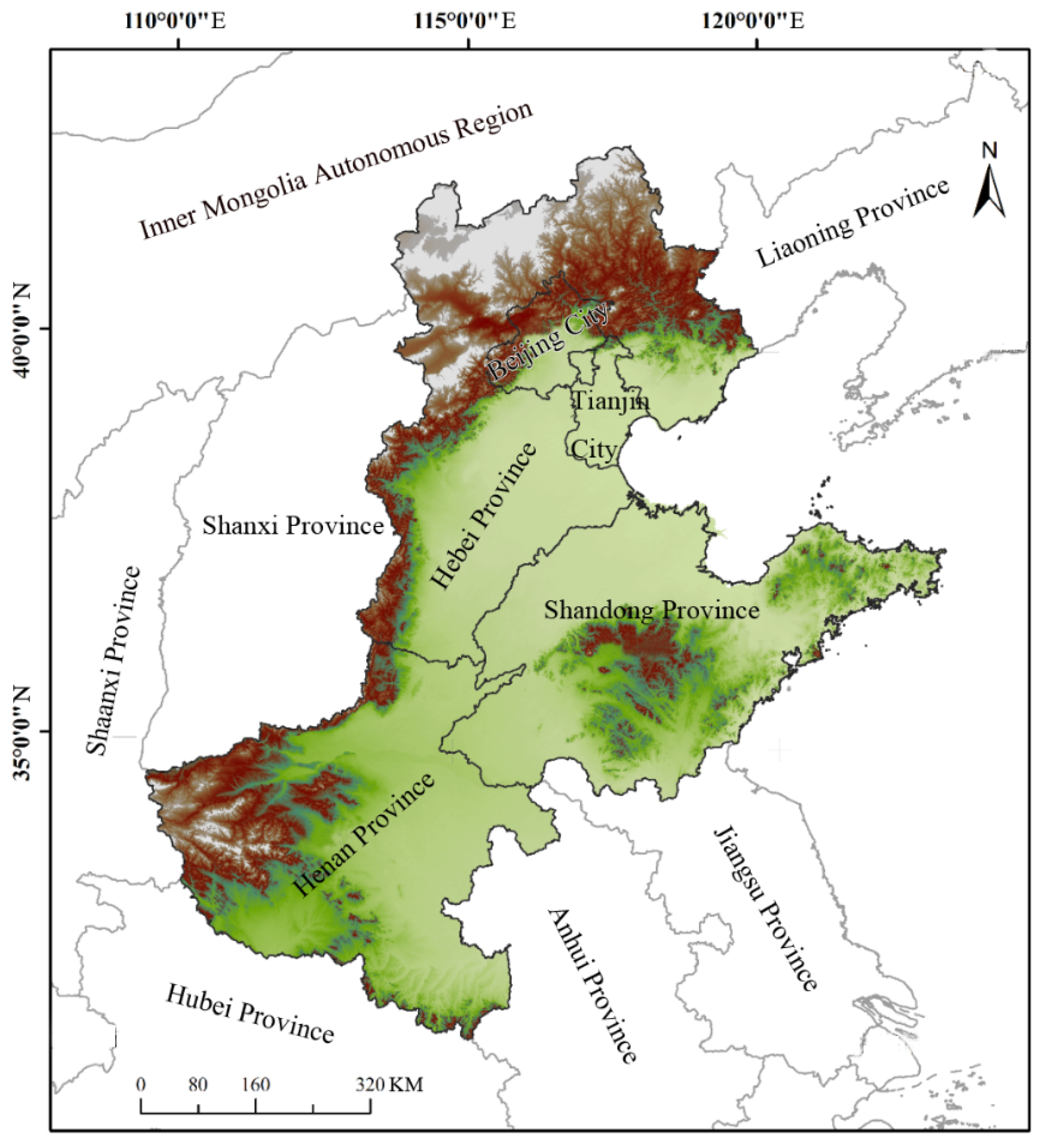

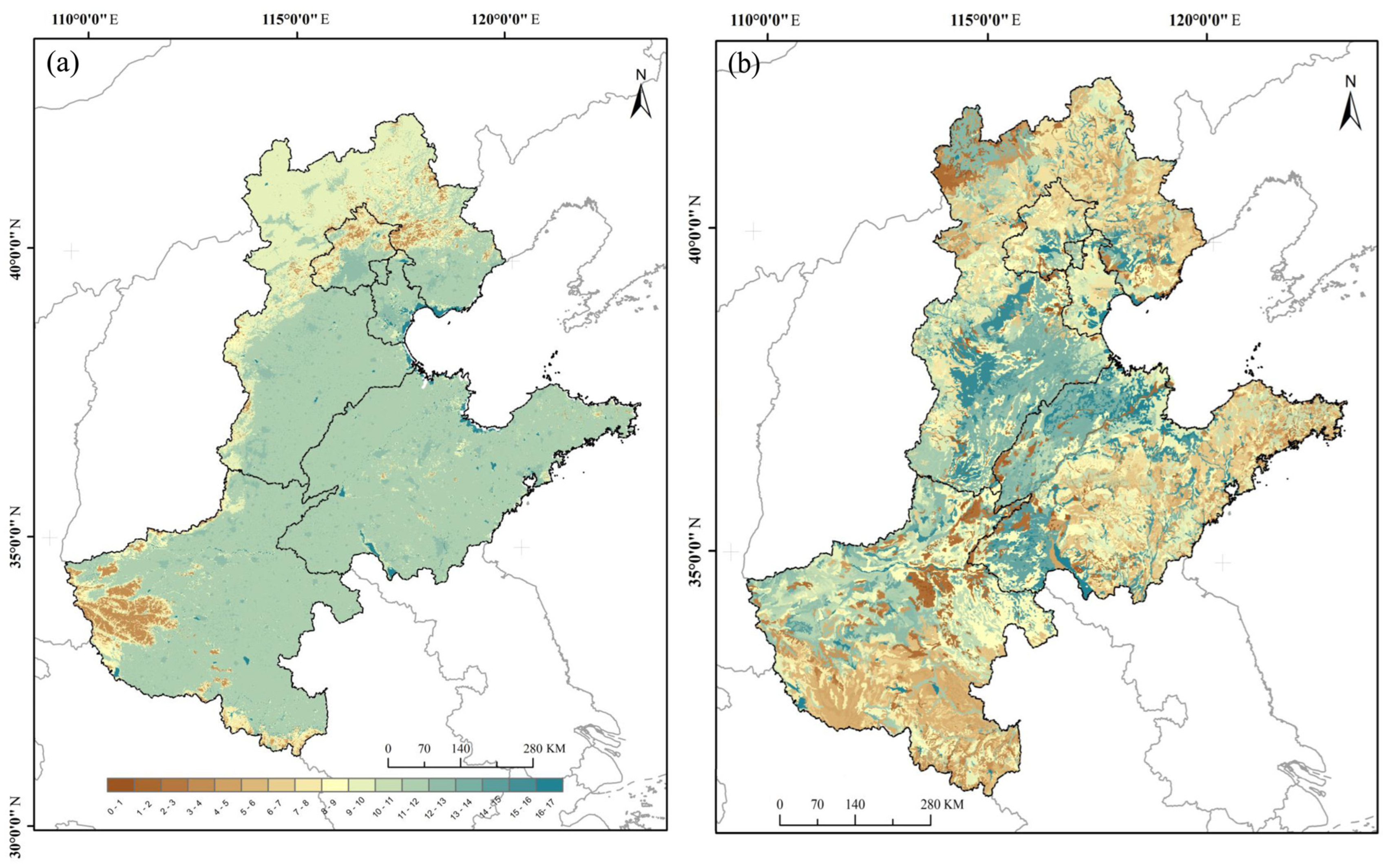
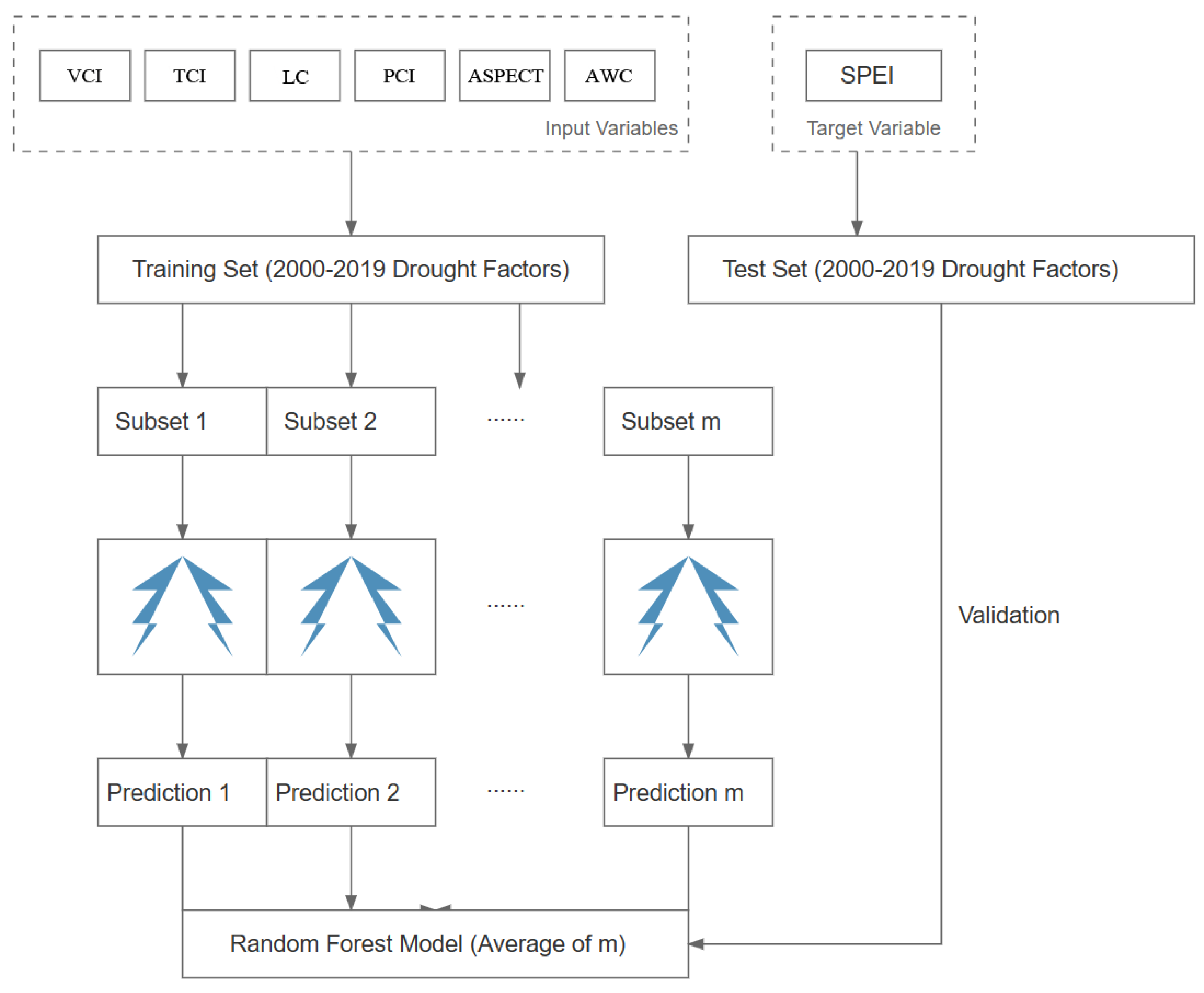
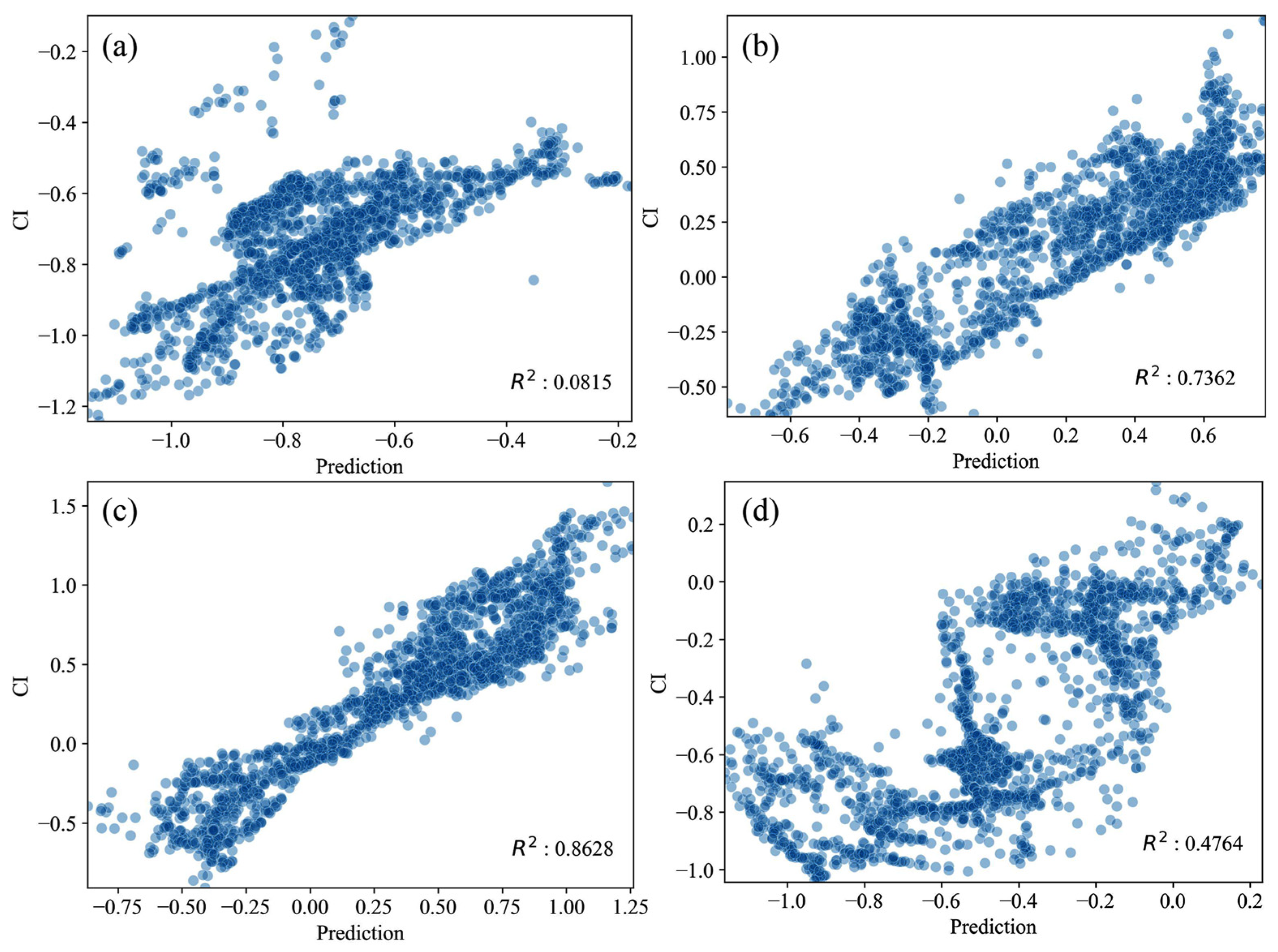
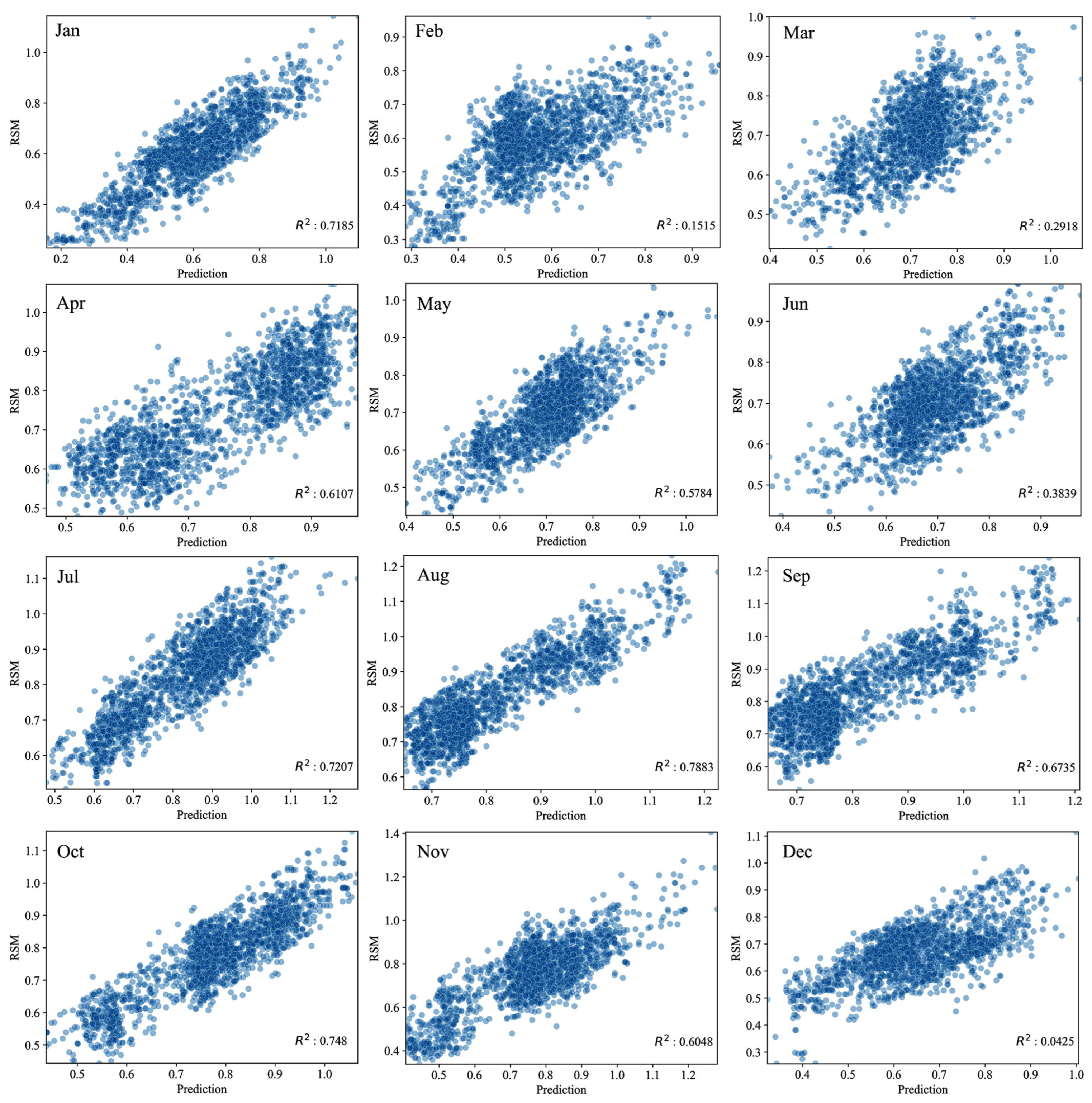
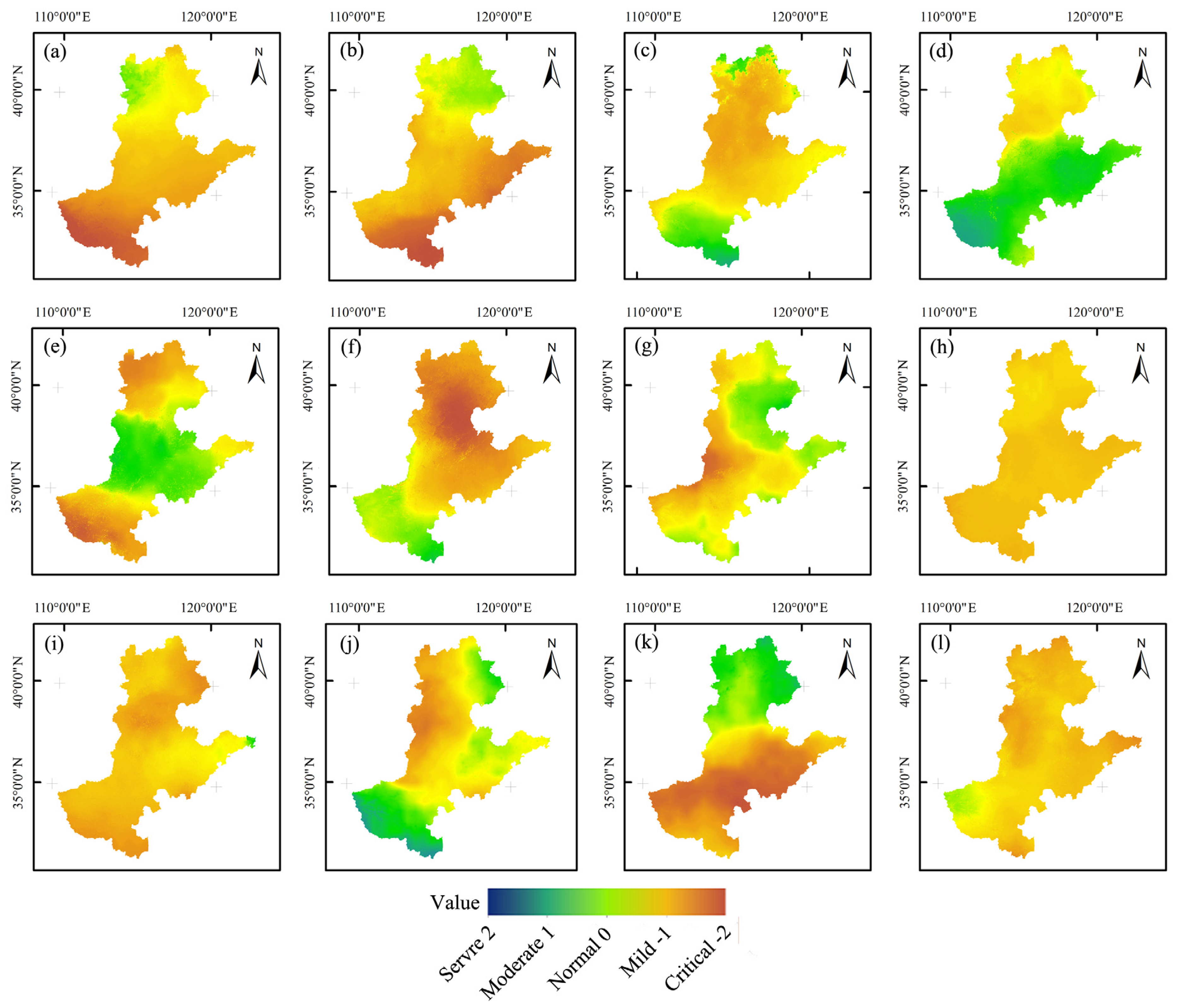
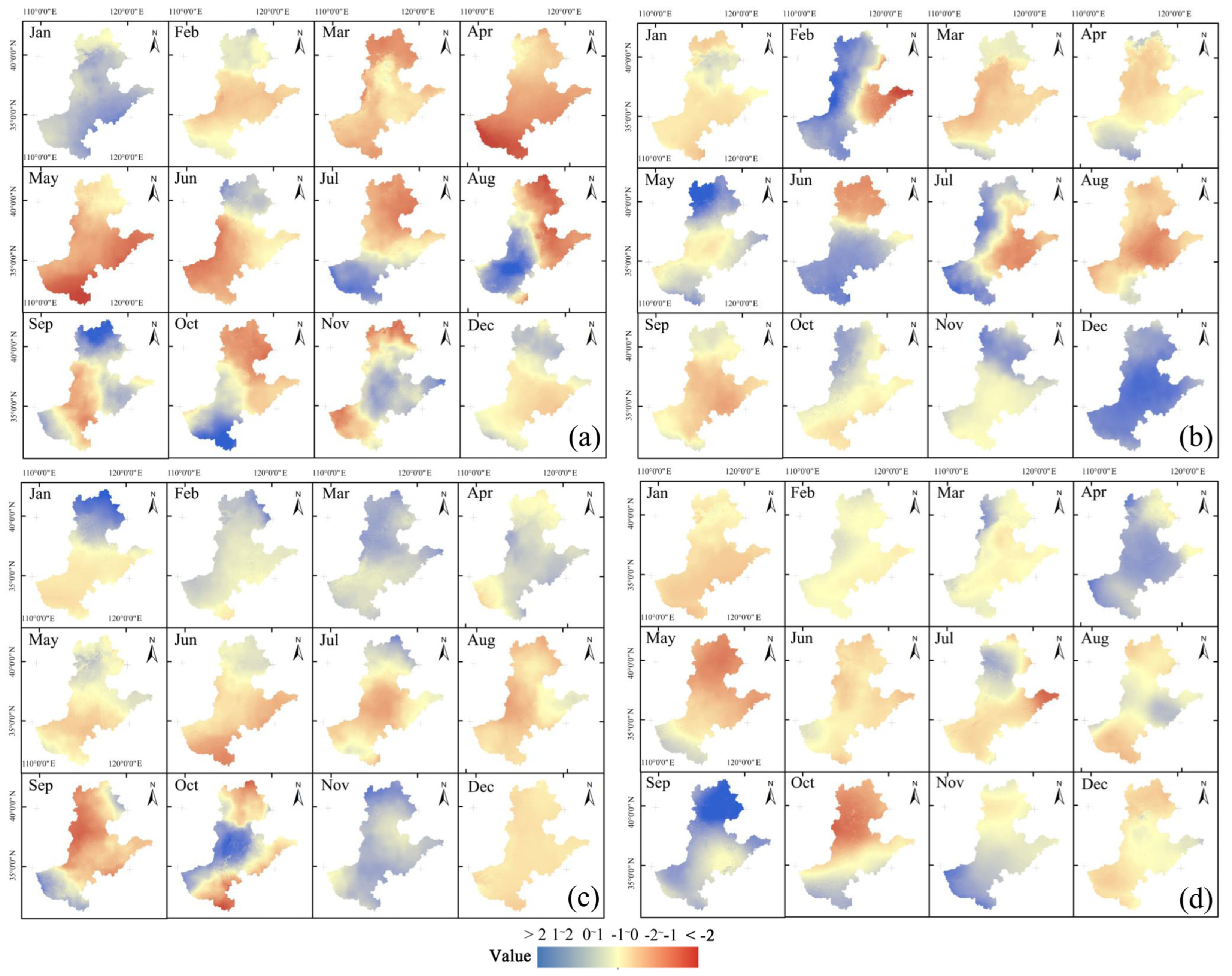

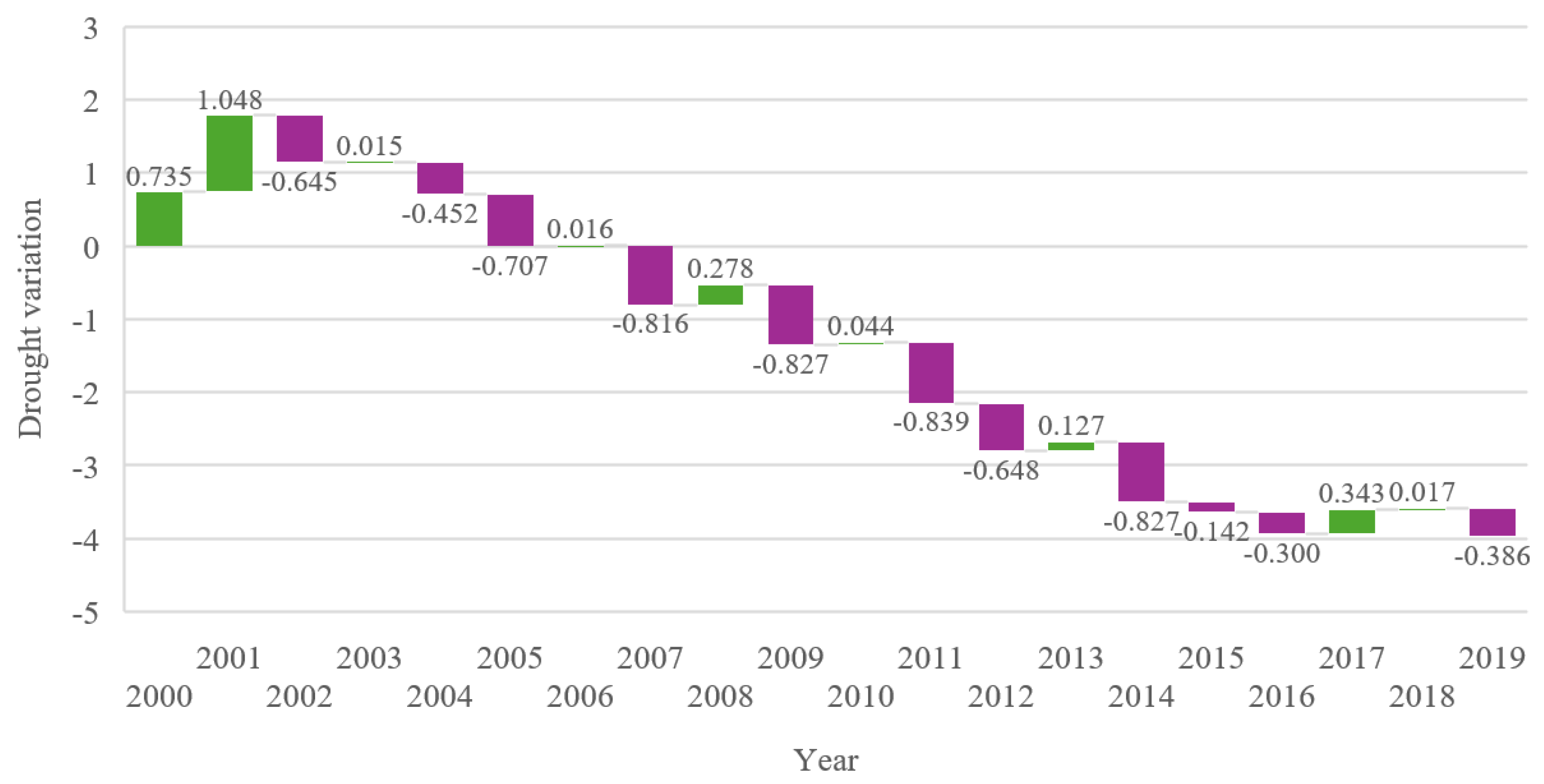
| Product | Spatial Resolution | Coordinate System | Temporal Resolution | Scale Factor |
|---|---|---|---|---|
| MOD13A3 | 1000 m | Sin | 16 days | 0.0001 |
| MOD11A2 | 1000 m | Sin | 8 days | 0.02 |
| MCD12Q1 | 500 m | Sin | Yearly | Not applicable |
| Drought Category | Number of Months |
|---|---|
| Mild drought ratio > 20% | 136 |
| Moderate drought ratio > 20% | 186 |
| Severe drought ratio > 20% | 63 |
| Exceptional drought ratio > 20% | 2 |
| Drought Category | Number of Months |
|---|---|
| Mild drought ratio > 30% | 101 |
| Moderate drought ratio > 30% | 147 |
| Severe drought ratio > 30% | 46 |
| Exceptional drought ratio > 30% | 3 |
Disclaimer/Publisher’s Note: The statements, opinions and data contained in all publications are solely those of the individual author(s) and contributor(s) and not of MDPI and/or the editor(s). MDPI and/or the editor(s) disclaim responsibility for any injury to people or property resulting from any ideas, methods, instructions or products referred to in the content. |
© 2025 by the authors. Licensee MDPI, Basel, Switzerland. This article is an open access article distributed under the terms and conditions of the Creative Commons Attribution (CC BY) license (https://creativecommons.org/licenses/by/4.0/).
Share and Cite
Meng, X.; Zhang, S.; Wang, G.; Ding, J.; Chu, C.; Zhang, J.; Wang, H. Decoding Agricultural Drought Resilience: A Triple-Validated Random Forest Framework Integrating Multi-Source Remote Sensing for High-Resolution Monitoring in the North China Plain. Remote Sens. 2025, 17, 1404. https://doi.org/10.3390/rs17081404
Meng X, Zhang S, Wang G, Ding J, Chu C, Zhang J, Wang H. Decoding Agricultural Drought Resilience: A Triple-Validated Random Forest Framework Integrating Multi-Source Remote Sensing for High-Resolution Monitoring in the North China Plain. Remote Sensing. 2025; 17(8):1404. https://doi.org/10.3390/rs17081404
Chicago/Turabian StyleMeng, Xianyong, Song Zhang, Guoqing Wang, Jianli Ding, Chengbin Chu, Jianyun Zhang, and Hao Wang. 2025. "Decoding Agricultural Drought Resilience: A Triple-Validated Random Forest Framework Integrating Multi-Source Remote Sensing for High-Resolution Monitoring in the North China Plain" Remote Sensing 17, no. 8: 1404. https://doi.org/10.3390/rs17081404
APA StyleMeng, X., Zhang, S., Wang, G., Ding, J., Chu, C., Zhang, J., & Wang, H. (2025). Decoding Agricultural Drought Resilience: A Triple-Validated Random Forest Framework Integrating Multi-Source Remote Sensing for High-Resolution Monitoring in the North China Plain. Remote Sensing, 17(8), 1404. https://doi.org/10.3390/rs17081404









